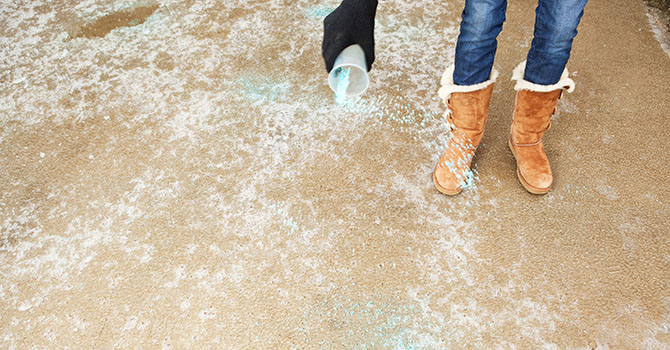

What you need to know
We use a salt management plan to help prevent excess salt from washing into our waterways. Below are some tips so you too can help minimize your impacts this winter.
Excess road salt damages vehicles and infrastructure, harms our pets and plants, and degrades waterways.
Once salt has dissolved in water, it’s always in the water. It only takes one teaspoon of road salt to permanently pollute about five gallons of water.
Salt can alter the pH level of soil and water which can be bad for plants, animals, and other organisms.
Cleaning up excess salt is important because what's left on the ground eventually makes its way into our soil and water supply, including surface water like creeks, streams, and groundwater.
Salt tips to minimize your impact
- Shovel first. Clear all snow from driveways and sidewalks before it turns to ice.
- Salt should only be used after the snow is removed and only in areas needed for safety.
- Make sure your salt is rated for the temperature, as some formulations stop working if the temperature is below about - 10 degrees celsius.
- Only use what you need to reduce the impact to pets, plants, waterways, and infrastructure. A 12-ounce coffee mug of salt should be enough for 500 square feet of driveway or 10 sidewalk slabs.
- If you’re a pet owner, remember to clean paws after walks and prevent pets from ingesting products while out.
- Distribute salt evenly, not in clumps. Clumped salt is wasted salt.
- Clean up excess salt to prevent it from getting into local water sources.
How the City manages salt
Our approach includes:
- Multiple salt based treatment products, including pre-wet, brine, and salt, that use varying concentrations of salt
- This enables crews to plan treatment approaches using the products that are most effective for the conditions, thereby minimizing excess use
- Installation of pavement temperature sensors on City equipment to assist in determining road temperature and appropriate treatment methods
- Installation of road weather information systems at key locations within the city to provide atmospheric and road temperature information
- Annual training on salt treatment methods to drivers, equipment operators, and crews
- Regular maintenance of equipment and calibration of our salt spreader controls to ensure equipment is working as intended
- Providing detailed information on and maps of treatment locations to crews
- Recording and reporting out on our usage and approach
- An established multi-year contract with a salt supplier
- Annual inspection of salt storage facilities
- An annual review of treatment approaches to identify, plan for, and implement improvements
